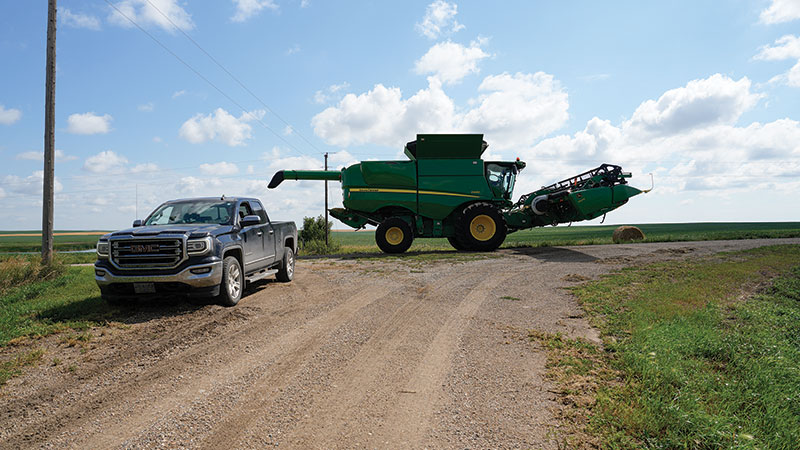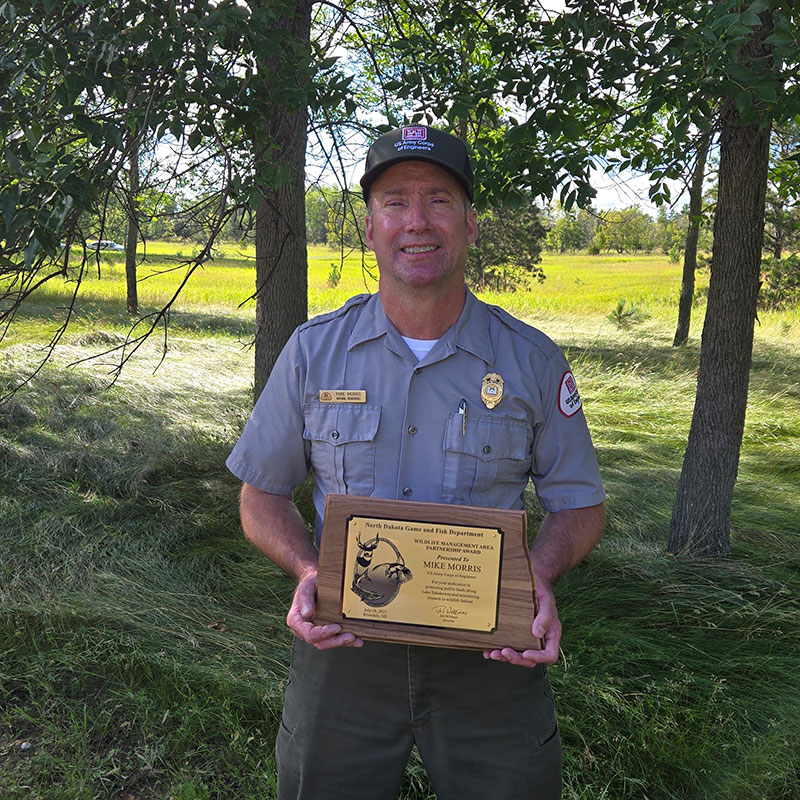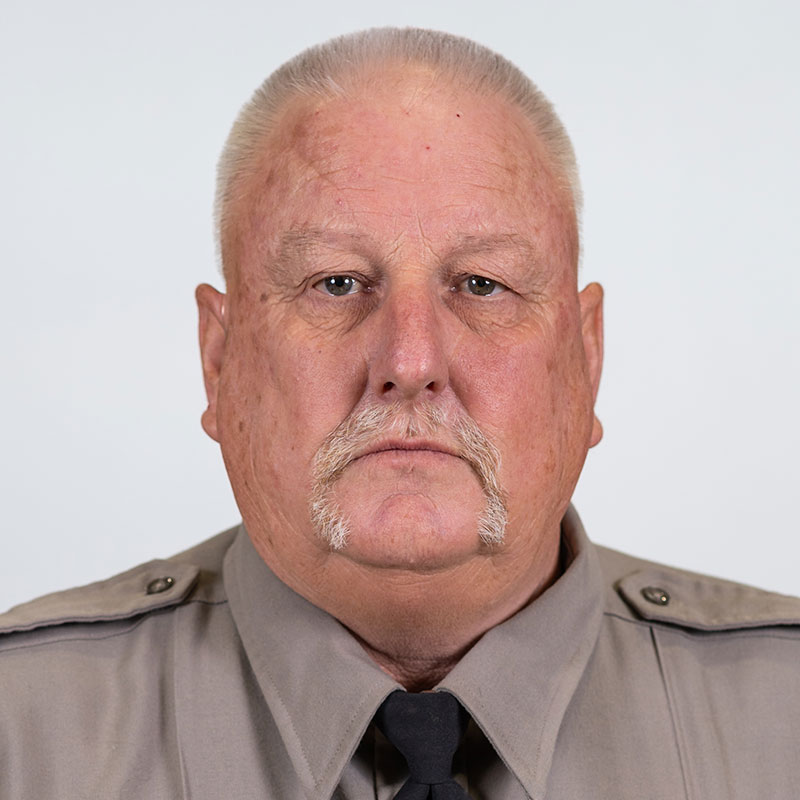
Buffaloberry Patch
New Hunting, Trapping Guide
Hunters and trappers can find the North Dakota 2025-26 Hunting and Trapping regulations, which includes upland game, migratory game bird and furbearer hunting/trapping regulations and other information online. Printed guides are available at the usual license vendor locations.
The 50-plus page guide also features a colored duck identification guide, aquatic nuisance species information, Tom Roster’s Nontoxic Shot Lethality Table and more.
Waterfowl Habitat Stamp, Federal Duck Stamp Requirements
A new North Dakota law requires all waterfowl hunters, regardless of age, to have a state-issued waterfowl habitat restoration stamp in possession while afield this fall. Waterfowl include ducks, geese, swans, mergansers and coots.
Senate bill 2216 requires every resident and nonresident waterfowl hunter to purchase an electronic waterfowl habitat restoration stamp for $5. Money generated from e-stamp sales is earmarked for the Waterfowl Habitat Improvement Fund, which is aimed at improving and restoring waterfowl habitat and supporting youth hunting programs.
In addition, a federal duck stamp is required for waterfowl hunters 16 and older beginning Sept. 1. The federal electronic duck stamp is valid for the entire waterfowl hunting season. A physical stamp will be mailed in March 2026 to individuals who purchased the e-stamp.
Those interested in buying physical federal duck stamps can purchase them at many U.S. Postal Service offices or the Amplex website, and Amplex should be used for hunters wanting to support conservation by purchasing extra duck stamps.
The federal duck stamp costs $25. An additional $4 processing fee is added.
This year’s stamps are available for electronic purchase through the North Dakota Game and Fish Department’s website, or license vendors registered with the department’s licensing system.
Get HIP Registered
Migratory bird hunters of all ages need to register with the Harvest Information Program prior to hunting ducks, geese, swans, mergansers, coots, cranes, snipe, doves and woodcock. Hunters must register in each state they are licensed to hunt.
Hunters can HIP certify when purchasing a license online.
Those who registered to hunt during the spring light goose conservation order in North Dakota do not have to register with HIP again, as it is required only once per year.
HIP registration is a cooperative program designed to determine a sample of hunters to measure harvest of migratory birds for management purposes.
Upland Game Wing Survey
Hunters can help in the effort to manage upland game birds in the state by collecting feathers from harvested birds and sending in wing envelopes.
Birds included in the North Dakota Game and Fish Department’s upland game wing survey, which has been in practice for decades, are ring-necked pheasants, sharp-tailed grouse, gray partridge (commonly referred to as Hungarian partridge), turkeys and ruffed grouse.
Collecting enough pheasant samples is typically never a problem, but securing enough sharptail and partridge feathers can be.
Game and Fish biologists will take as many sharptail and partridge feathers as they can get because the more collected, the better the data. Biologists can determine sex and age ratios from wings and tail feathers, survival, nesting success, hatch dates and overall production.
What biologists learn from the samples is vital to helping manage North Dakota’s upland game birds.
Hunters interested in receiving wing envelopes can order online, or contact the Department’s main office in Bismarck at 701-328-6300.
Hunters can also get wing envelopes at Game and Fish District offices in Devils Lake, Jamestown, Riverdale, Dickinson, Williston and Lonetree Wildlife Management Area near Harvey.
WMA Equipment Restrictions
While it was legal for hunters to place tree stands, ground blinds and game cameras on state wildlife management areas in late August, they are reminded that equipment set out prior to that date, or left on a WMA after January 31, is considered abandoned property and is subject to removal.
In addition, an equipment registration number, or the owner’s name, address and telephone number, must be displayed on all equipment requiring identification.
Owners can generate an equipment registration number online. One registration number will be issued that can be used on all equipment that requires identification.
Fall Fire Danger Index
As hunting seasons and other fall activities get underway, hunters and other outdoor enthusiasts need to be aware of the daily fire danger index.
There is a lot of fuel on the landscape, and hunters are urged to keep up with the daily rural fire danger index, which is issued by the National Weather Service, to alert the public to conditions that may be conducive to the accidental starting or spread of fires.
In addition, county governments have the authority to adopt penalties for violations of county restrictions related to burning bans. These restrictions apply regardless of the daily fire danger index and remain in place until each county’s commission rescinds the ban.
Hunters should consider bringing along a shovel, fire extinguisher, extra water and heavy fabric for putting out accidental fires. However, individuals who are not trained firefighters should not attempt to fight a fire that is out of control. Instead, contact the nearest rural fire department immediately.
Also, hunters should stay clear of tall vegetation when parking a vehicle.
The fire danger index can change daily depending on temperature, wind and precipitation forecasts. If the index reaches the high, very high or extreme category, open burning is prohibited; off-road travel with a motorized vehicle is prohibited, except for people engaged in a trade, business or occupation where it is required; and smoking is restricted to inside of vehicles, hard surface areas, homes or in approved buildings.
Information on current fire danger indexes is available at ndresponse.gov.
PLOTS Guide Online
The North Dakota Game and Fish Department’s Private Land Open To Sportsmen Guide for 2025 is now available online at the Game and Fish website.
The guide will feature about 880,000 PLOTS acres. Because PLOTS tracts can be added or removed from the program throughout the year, hunters are encouraged to use the Game and Fish mobile app or other mapping and browser-based applications to locate and identify these tracts. Map sheets are updated weekly on the Department’s website.
The PLOTS guide features maps highlighting these walk-in areas, identified in the field by inverted triangular yellow signs, as well as other public lands.
To maximize the use of hunter dollars, fewer signs will be placed on PLOTS tracts in the future. The cost savings will be directed to the addition of more habitat and access.
The free printed PLOTS guides are available at most license vendors and other locations throughout the state. The guides are not available by mail, so hunters will have to pick one up at a local vendor or Game and Fish offices or print individual maps from the website.

Pull to the Right
North Dakota hunters need to be cautious of farm, ranch and other traffic when traveling on rural roads.
Fall is a busy time in the state as farmers and ranchers are harvesting crops, moving cattle, hauling bales and moving heavy machinery. Knowing this, hunters driving around on country roads should slow down when meeting another vehicle and pull well to the right when topping a hill.
To maintain positive landowner/hunter relations, Game and Fish Department officials said hunters should move to the right side of the road to allow wide farm vehicles to pass, park vehicles in a place that will not block a roadway, field approach or gate, pick up trash and empty shells, and not clean game in the road ditch or approach.
Watchable Wildlife Photo Contest
Photographers interested in sending photos for the North Dakota Game and Fish Department’s Watchable Wildlife Photo Contest are asked to follow the guidelines for submitting their work.
Photographers should go to the Game and Fish Department’s website. Then it is a matter of providing some pertinent information about the photo and uploading it. Doing so helps both with ease of submitting photos for the photographer and managing those images for Department staff.
The contest is now open and the deadline for submitting photos is Oct. 1. For more information or questions, contact Patrick Isakson, Department conservation supervisor, at pisakson@nd.gov.
The contest has categories for nongame and game species, as well as plants/insects. An overall winning photograph will be chosen, with the number of place winners in each category determined by the number of qualified entries.
Contestants are limited to no more than five entries. Photos must have been taken in North Dakota.
By submitting an entry, photographers grant permission to Game and Fish to publish winning photographs in North Dakota OUTDOORS, and on the Department’s website.

Morris Earns WMA Award
The North Dakota Game and Fish Department recognized Mike Morris, with the U.S. Army Corps of Engineers, in July with its Wildlife Management Area Partnership Award
“It seems that Mike always works on very challenging and politically impacted projects … and he always found a way to mitigate and lessen the impacts to wildlife and wildlife habitat,” said Bill Haase, Game and Fish Department wildlife division chief. “Mike is always thinking about how to lessen the impact on wildlife habitat and gain something to make the situation more palatable, whether on a WMA or corps-managed lands. Mike is also very active in setting up our annual coordination meetings between our agencies and is always a champion of working together and building strong working relationships.”
Staff Notes

Warden Skuza Retires
Ken Skuza, longtime North Dakota Game and Fish Department game warden, retired after 31 years with the agency.
Skuza started his career with the Department in the Kenmare enforcement district and spent the last 24 years in Riverdale.
“Ken was extremely hardworking and was dedicated to serving North Dakota, the Game and Fish Department, and those who enjoy hunting, fishing, boating, and trapping in the state. Ken’s knowledge and experience will be missed,” said Scott Winkelman, enforcement division chief.

Assistant Wildlife Chief Named
Levi Jacobson was hired in August as the North Dakota Game and Fish Department’s assistant wildlife division chief.
Jacobson started his career with the Department in 2006 as a seasonal wildlife employee in Devils Lake. Before moving to his new position, Jacobson was a wildlife resource management supervisor in Bismarck for about four years.

Palarski Hired for Supervisor Role
John Palarski was named migratory game bird management supervisor for the North Dakota Game and Fish Department in August.
Palarski was hired in fall 2024 as the Department’s migratory game bird biologist before making the transition.
